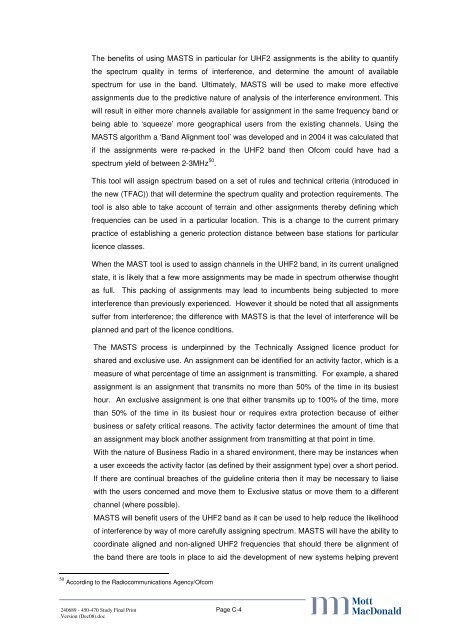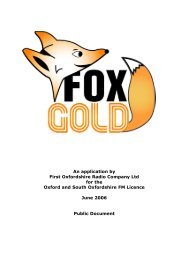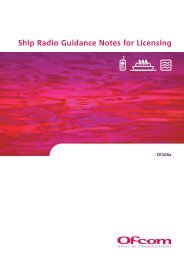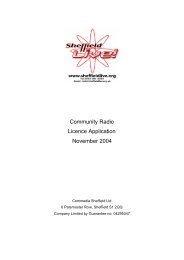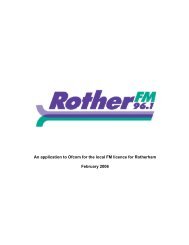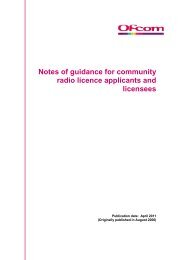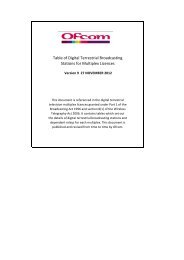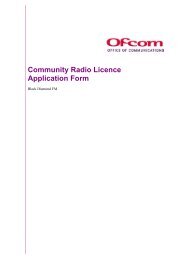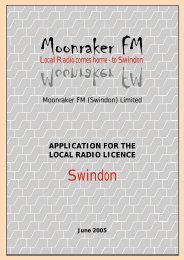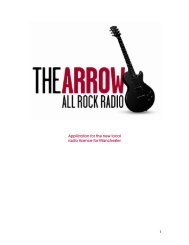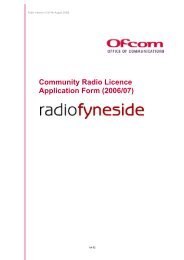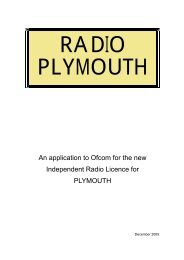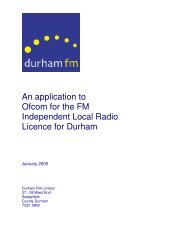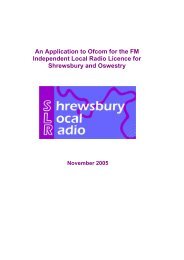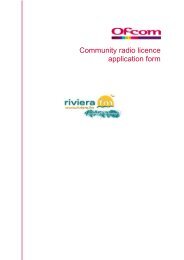UHF2 realignment study - Ofcom Licensing
UHF2 realignment study - Ofcom Licensing
UHF2 realignment study - Ofcom Licensing
Create successful ePaper yourself
Turn your PDF publications into a flip-book with our unique Google optimized e-Paper software.
The benefits of using MASTS in particular for <strong>UHF2</strong> assignments is the ability to quantify<br />
the spectrum quality in terms of interference, and determine the amount of available<br />
spectrum for use in the band. Ultimately, MASTS will be used to make more effective<br />
assignments due to the predictive nature of analysis of the interference environment. This<br />
will result in either more channels available for assignment in the same frequency band or<br />
being able to ‘squeeze’ more geographical users from the existing channels. Using the<br />
MASTS algorithm a ‘Band Alignment tool’ was developed and in 2004 it was calculated that<br />
if the assignments were re-packed in the <strong>UHF2</strong> band then <strong>Ofcom</strong> could have had a<br />
spectrum yield of between 2-3MHz 50 .<br />
This tool will assign spectrum based on a set of rules and technical criteria (introduced in<br />
the new (TFAC)) that will determine the spectrum quality and protection requirements. The<br />
tool is also able to take account of terrain and other assignments thereby defining which<br />
frequencies can be used in a particular location. This is a change to the current primary<br />
practice of establishing a generic protection distance between base stations for particular<br />
licence classes.<br />
When the MAST tool is used to assign channels in the <strong>UHF2</strong> band, in its current unaligned<br />
state, it is likely that a few more assignments may be made in spectrum otherwise thought<br />
as full. This packing of assignments may lead to incumbents being subjected to more<br />
interference than previously experienced. However it should be noted that all assignments<br />
suffer from interference; the difference with MASTS is that the level of interference will be<br />
planned and part of the licence conditions.<br />
The MASTS process is underpinned by the Technically Assigned licence product for<br />
shared and exclusive use. An assignment can be identified for an activity factor, which is a<br />
measure of what percentage of time an assignment is transmitting. For example, a shared<br />
assignment is an assignment that transmits no more than 50% of the time in its busiest<br />
hour. An exclusive assignment is one that either transmits up to 100% of the time, more<br />
than 50% of the time in its busiest hour or requires extra protection because of either<br />
business or safety critical reasons. The activity factor determines the amount of time that<br />
an assignment may block another assignment from transmitting at that point in time.<br />
With the nature of Business Radio in a shared environment, there may be instances when<br />
a user exceeds the activity factor (as defined by their assignment type) over a short period.<br />
If there are continual breaches of the guideline criteria then it may be necessary to liaise<br />
with the users concerned and move them to Exclusive status or move them to a different<br />
channel (where possible).<br />
MASTS will benefit users of the <strong>UHF2</strong> band as it can be used to help reduce the likelihood<br />
of interference by way of more carefully assigning spectrum. MASTS will have the ability to<br />
coordinate aligned and non-aligned <strong>UHF2</strong> frequencies that should there be alignment of<br />
the band there are tools in place to aid the development of new systems helping prevent<br />
50 According to the Radiocommunications Agency/<strong>Ofcom</strong><br />
240689 - 450-470 Study Final Print<br />
Version (Dec08).doc<br />
Page C-4<br />
abc


